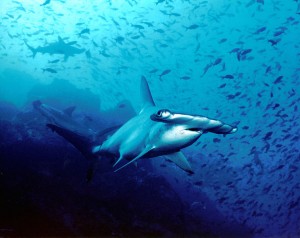FRIDAY, 14 MAY 2010
Using a 50-year-old specimen from the Natural History Museum in London, University of Bath's Dr. Jonathan Cox and researchers from the University of Cambridge carried out CT scans to construct a digital, three-dimensional representation of a hammerhead shark. They then proceeded to fashion a physical model of the head and nasal cavity by printing 178 μm thin layers. In closed-circuit free-surface water tunnels, flow visualisation experiments were conducted with food colouring [1].A shark's olfactory chamber consists of folded layers that form channels; the main ones connect to the incurrent and excurrent nostrils. The receptor cells are situated on the secondary channels that branch out. As sharks swim their heads glide from side to side and water is propelled in different angles across the channels. The experiment considered this flow of water, taking these angles into account.
Water enters the shark's nasal cavity through the incurrent nostril, passes through the incurrent and excurrent channels and exits through the excurrent nostril. Between the channels, the water traverses the secondary channels and possibly, as discovered in this study, a hairpin bend.
The point at which the water reaches the anterior side of the head determines the extent of percolation of the water through the channels. This can have an important impact on the information about smell gleaned from it. There are numerous deflecting mechanisms that control flow into the olfactory chamber: the major and minor nasal grooves, nasal bridge and depression behind the nostrils. These may also function to protect the sensitive folded layers from the continuous flow.
This research has brought together various fields of science, ranging from technology to marine biology. Although the scientists recognise that modelling structures at such an intricate level is not yet a perfected procedure, they hope that it will aid in future projects involving chemical sensors.
Written by Ayesha Sengupta

